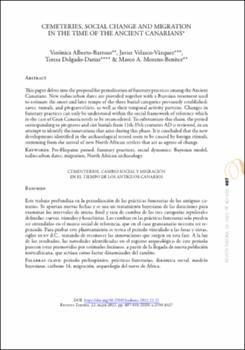Cemeteries, social change and migration in the time of the Ancient Canarians
Fecha
2022Resumen
This paper delves into the proposal for periodisation of funerary practices among the Ancient Canarians. New radiocarbon dates are provided together with a Bayesian treatment used to estimate the onset and later tempo of the three burial categories previously established: caves, tumuli, and pit-graves/cists, as well as their temporal activity patterns. Changes in funerary practices can only be understood within the social framework of reference which in the case of Gran Canaria needs to be reconsidered. To substantiate this claim, the period corresponding to pit-graves and cist burials from 11th-15th centuries AD is reviewed, in an attempt to identify the innovations that arise during this phase. It is concluded that the new developments identified in the archaeological record seem to be caused by foreign stimuli, stemming from the arrival of new North African settlers that act as agents of change. Este trabajo profundiza en la periodización de las prácticas funerarias de los antiguos ca-narios. Se aportan nuevas fechas y se usa un tratamiento bayesiano de las dataciones para examinar los intervalos de inicio, final y tasa de cambio de las tres categorías sepulcrales definidas: cuevas, túmulos y fosas/cistas. Los cambios en las prácticas funerarias solo pueden ser entendidos en el marco social de referencia, que en el caso grancanario necesita ser re-pensado. Para probar este planteamiento se testea el periodo vinculado a las fosas y cistas, siglos xi-xv d.C., tratando de reconocer las innovaciones que surgen en esta fase. A la luz de los resultados, las novedades identificadas en el registro arqueológico de este periodo parecen estar promovidas por estímulos foráneos, a partir de la llegada de nueva población norteafricana, que actúan como factor dinamizador del cambio.





